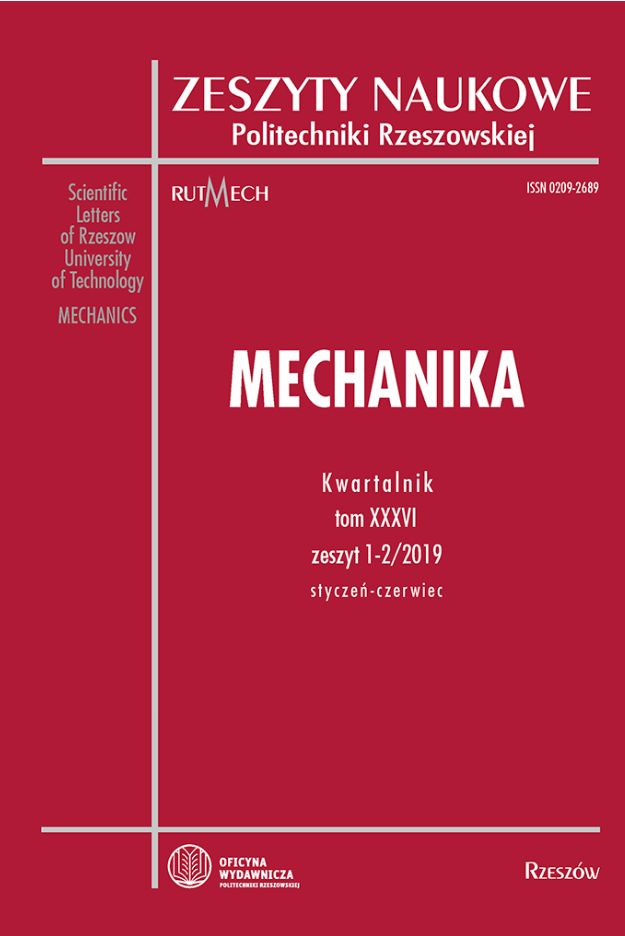Abstract
This article evaluates the effectiveness of selected micromechanical models, such as Folgar-Tucker and RSC, in numerical calculations concerning fiber orientation prediction in a polymer matrix for the WPC composite containing 15% by mass of wood fibers. In addition, the obtained values of fiber orientation tensor in the polymer matrix allowed to assess the influence of the applied micromechanical models on the possibilities of predicting the mechanical properties of the WPC composite using the Mori-Tanaka homogenization model. It should be noted that the default micromechanical model suggested in CAE software including the injection moulding process modules is the Folgar-Tucker model. Hence, it is important to investigate whether the second optional model, i.e. RSC, should be the main model used in predicting the processing and mechanical properties of WPC composites.
References
Klyosov A.A.: Wood-plastic composites, Wiley, New Jersey 2007.
Kaczmar J.W., Pach J.: Kompozyty polimerowe wzmacniane włóknami naturalnymi, Tworzywa Sztuczne i Chemia, 4 (2007) 14-16.
Ziąbka M., Szaraniec B.: Kompozyty polimerowe z dodatkiem włókien naturalnych, Kompozyty, 10 (2010) 138-142.
Wechsler A., Hiziroglu S.: Some of the properties of wood-plastic composites, Building Environment, 42 (2007) 2637-2644.
Frącz W., Janowski G.: Zaawansowana analiza wytrzymałościowa wypraski z kompozytu WPC z uwzględnieniem powtryskowej orientacji włókien w osnowie polimerowej, Mechanik, 7 (2016) 628-630.
Frącz W., Janowski G.: Strength analysis of molded pieces produced from wood-polymer composites (WPC) including their complex structures, Composites Theory Practice, 16 (2016) 260-265.
Jeziorny A.: Skrypty dla szkół wyższych. Nauka o włóknie, Redakcja Wydawnictw Naukowych Politechniki Łódzkiej, Łódź 1980.
Miedzianowska J., Masłowski M., Strzelec K.: Kompozyty polimerowe zawierające włókna roślinne – czynniki wpływające na wytrzymałość mechaniczną, Technologia i Jakość Wyrobów, 63 (2018) 45-54.
Wire S.L.: Fibre Orientation and mechanical properties of fibre reinforced composites. Praca doktorska, University of Leeds, Leeds 1998.
Nabialek J.: Modeling of fiber orientation during injection molding process of polymer composites, Kompozyty, 11 (2011) 347-351.
Jeffery G.B.: The motion of ellipsoidal particles immersed in viscous fluid, Proc. Royal Society London A, 102 (1922) 161-179.
Dinh S.M., Armstrong R.C.: A rheological equation of state for semi-concentrated fiber suspensions, J. Rheology, 28 (1984) 207-227.
Folgar F., Tucker C.L.: Orientation behavior of fibers in concentrated suspensions, J. Reinforced Plastics Composites, 3 (1984) 98-119.
Wang J., O’Gara J.F., Tucker III C.L.: An objective model for slow orientation kinetics in concentrated fiber suspensions: Theory and rheological evidence, J. Rheology, 52 (2008) 1179-1200.
Tucker III C.L., Wang J., O’Gara J.F.: Method and Article of Manufacture for Determining a Rate of Change of Orientation of a Plurality of Fibers Disposed in a Fluid, US Patent US7266469B1, 2007.
Buck F., Brylka B., Müller V., Müller T., Hrymak A.N., Henning F., Böhlke T.: Coupling of mold flow simulations with two-scale structural mechanical simulations for long fiber reinforced thermoplastics, Mater. Sci. Forum, 825 (2015) 655-662.
Kleindel S., Salaberger D., Eder R., Schretter H., Hochenauer C.: Prediction and validation of short fiber orientation in a complex injection molded part with chunky geometry, Int. Polymer Processing, 30 (2015) 366-380.
Pomoc programu Autodesk Moldflow Insight 2016.
Meyer K.J., Hofmann J.T., Baird D.G.: Prediction of short glass fiber orientation in the filling of an end-gated plaque, Composites Part A: Appl. Sci. Manuf., 62 (2014) 77-86.
Amirmaleki M., Samei J., Green D.E., Van Riemsdijk I., Stewart L.: 3D micromechanical modeling of dual phase steels using the representative volume element method, Mech. Materials, 101 (2016) 27-39.
Singh R., Mitra M., Falzon B.G.: Modelling matrix damage and fibre–matrix interfacial decohesion in composite laminates via a multi-fibre multi-layer representative volume element (M2RVE), Int. J. Solids Structures, 51 (2014) 449-461.
Pierard O., LLorca J., Segurado J., Doghri I.: Micromechanics of particle-reinforced elasto-viscoplastic composites: finite element simulations versus affine homogenization, Int. J. Plasticity, 23 (2007) 1041-1060.
Mori T., Tanaka K.: Average stress in matrix and average elastic energy of materials with misfitting inclusions, Acta Metallurgica, 21 (1973) 571-574.
Eshelby J.D.: The determination of the elastic field of an ellipsoidal inclusion, and related problems, Proceedings of the Royal Society of London A: Math., Physical Eng. Sci., 241 (1957) 376-396.
Ogierman W., Kokot G.: Mean field homogenization in multi-scale modelling of composite materials, J. Achievements Mater. Manuf. Eng., 61 (2013) 343-348.
Benveniste Y.: A new approach to the application of Mori-Tanaka's theory in composite materials, Mech. Materials, 6 (1987) 147-157.


